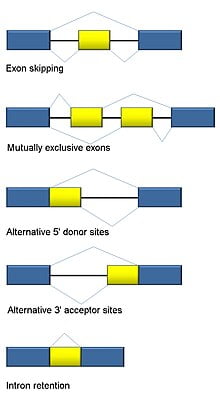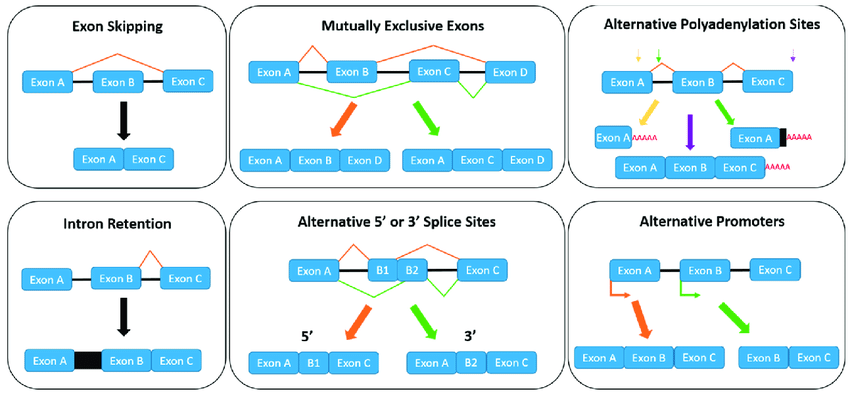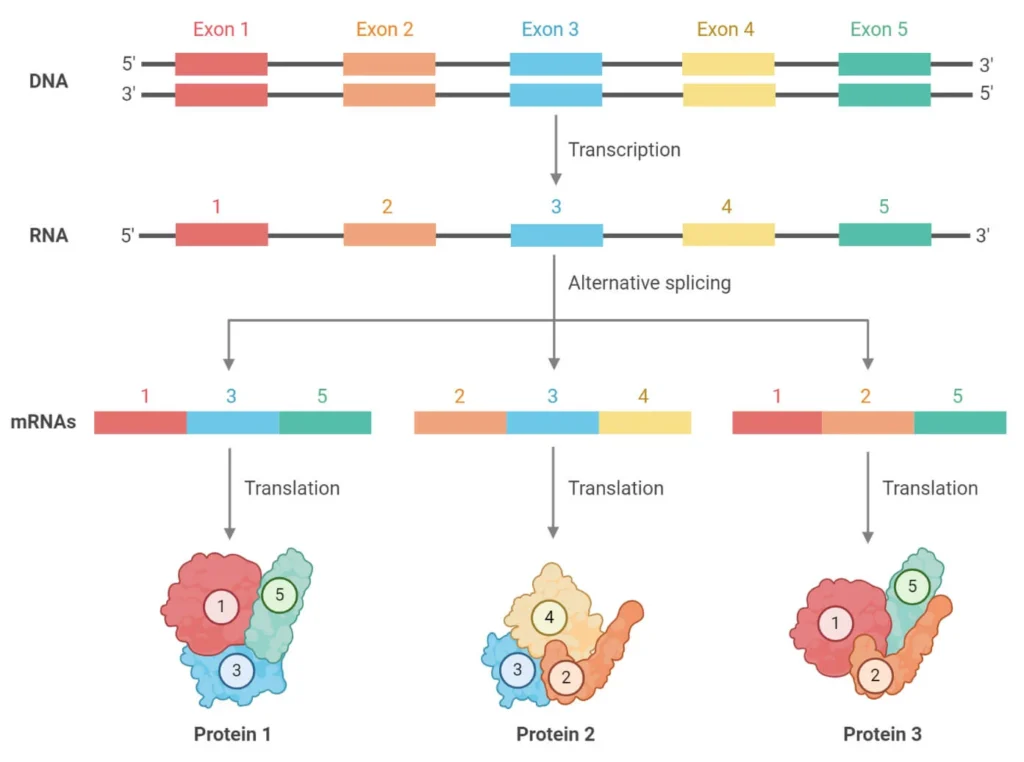Alternative splicing is a process during gene expression where different combinations of exons within a pre-mRNA transcript can be spliced together, resulting in multiple mRNA isoforms derived from a single gene. This process allows for the production of structurally and functionally diverse proteins from a single gene.
Table of Contents
Alternative Splicing- Definition
During the molecular process of gene expression known as alternative splicing, distinct exon combinations within a pre-mRNA transcript can be spliced together to produce various mRNA isoforms generated from a single gene. Protein diversity and regulatory complexity in eukaryotic organisms are increased by this process, which enables the synthesis of several structurally and functionally distinct proteins from a single gene.

Mechanism of Alternative Splicing
1. Interpretation
RNA polymerase II converts DNA into pre-mRNA. Both intronic (non-coding) and exonic (coding) sections are present in the pre-mRNA.
2. Spliceosome Construction
The spliceosome, a large ribonucleoprotein complex made up of small nuclear ribonucleoproteins (snRNPs) and related proteins, is connected with the pre-mRNA transcript.
3. Finding the Splice Sites
Splice sites are the precise sequences that the spliceosome identifies at the ends of exons and introns.
The 5′ splice site (donor site), the 3′ splice site (acceptor site), and the branch point sequence inside the intron are important splice sites.
4. Splicing Patterns
Splicing patterns and mRNA isoforms can be produced by utilizing various combinations of splice sites during the process.
Regulatory components present in the pre-mRNA, such as splicing silencers (ESSs, ISSs) and exonic and intronic splicing enhancers (ESEs, ISEs), affect splicing patterns.
5. Splice Site Selection
The consensus sequences at the 5′ and 3′ splice sites are bound by spliceosome components, bringing them closer together.
Following cleavage at the 5′ splice site, the free 5′ end of the intron attacks the branch point sequence with a nucleophile to generate a lariat structure.
After that, the 3′ splice site is broken, the exons are combined, and the intron is released in the shape of a lariat.
6. Exclusion or Exon Inclusion:
Different exon combinations may be included or omitted from the final mRNA transcript depending on the choice of splice sites.
Among the mechanisms leading to alternate splicing patterns include exon skipping, mutually exclusive exons, alternative 5′ or 3′ splice sites, intron retention, and alternative promoters.
7. mRNA Processing:
The mRNA transcript passes through other processing stages after splicing, such as capping, polyadenylation, and nuclear export, before being translated into a protein.
8. Creation of Protein Isoforms
Multiple mRNA isoforms are produced by alternative splicing, and these isoforms may encode distinct protein isoforms with varying structural and functional characteristics.
Types of Alternative Splicing

1. Exon Skipping
This kind results in the exclusion of one or more exons from the mature mRNA transcript because these exons are skipped during splicing.
2. Alternative 5′ Splice Site
Various exons are included at the start of the mRNA transcript as a result of the use of distinct 5′ splice sites within an intron.
3. Alternative 3′ Splice Site
Various exons are included at the end of the mRNA transcript as a result of using distinct 3′ splice sites within an intron.
4. Intron Retention
This kind occurs when one or more introns are not spliced out but remain part of the mature mRNA transcript.
5. Mutually Exclusive Exons
When two or more neighboring exons are mutually exclusive, only one of the exons is present in the final transcript of the mRNA.
6. Alternative Promoter Usage
Different initial exons are included in the mRNA transcript as a result of the usage of different transcription start sites.
Uses of Alternative Splicing

1. Protein Diversity
More proteome diversity is possible because alternative splicing helps produce several protein isoforms from a single gene. This broadens the proteome’s functional repertoire by allowing cells to synthesize proteins with various shapes and roles.
2. Control of Gene Expression
By limiting the synthesis of particular mRNA isoforms, alternative splicing is essential in managing the expression of genes. Cells are able to modify their gene expression profiles in response to many inputs, including environmental stimuli, developmental cues, and cellular signals.
3. Cellular Differentiation
In order to produce tissue-specific mRNA isoforms, alternative splicing plays a role in cellular differentiation and development. These tissue-specific isoforms could encode proteins with particular roles necessary for the growth and upkeep of particular cell types and tissues.
4. Therapeutic and Diagnostic Targets
In some cases, aberrant alternative splicing patterns can function as prognostic or diagnostic biomarkers. Furthermore, a promising therapeutic approach for the therapy of disease is to target alternative splicing mechanisms. Developing therapeutic approaches through the manipulation of splicing factors or splicing regulatory components might open up new possibilities.
5. Biotechnological Applications
Synthetic mRNA transcript design for gene expression research and the creation of mRNA-based medicines are two examples of the biotechnological uses for alternative splicing. Designing mRNA isoforms with specific features for a range of uses can be made easier by comprehending and adjusting alternative splicing processes.
Frequently Asked Question
What is Alternative Splicing?
Different combinations of exons within a pre-mRNA transcript can be spliced together during alternative splicing, a biological process that occurs during gene expression in eukaryotic organisms and produces numerous mRNA isoforms generated from a single gene. The proteome complexity of eukaryotic creatures is considerably increased by this process, which produces proteins with a wide range of structural and functional diversity from a single gene.
What is Uses of Alternative Splicing ?
The uses of alternative splicing are:
1.Protein Diversity
2. Control of Gene Expression
3. Cellular Differentiation
4. Therapeutic and Diagnostic Targets
5. Biotechnological Applications
Related Articles
Affinity Chromatography- Definition, Principle, Parts, Steps, Uses

